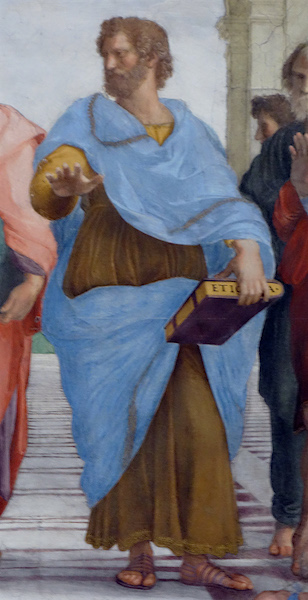The conservator’s eye, Rembrandt van Rijn’s Aristotle with a Bust of Homer, 1653, oil on canvas, 56 1/2 x 53 3/4″ / 143.5 x 136.5 cm (The Metropolitan Museum of Art). Speakers: Jim Coddington and Beth Harris
[0:00] [music]
Dr. Beth Harris: [0:04] We’re standing in the Metropolitan Museum of Art, looking at a painting that I’ve loved for many years. This is Rembrandt’s “Aristotle Contemplating the Bust of Homer,” and I’m looking at it today with Jim Coddington, who was for many years the chief conservator at the Museum of Modern Art.
[0:22] What I’m drawn to is the surface of the painting, the areas where the brushwork seems quick, almost like Rembrandt is showing off in his ability to depict texture, but other areas where it’s thickly built up.
James Coddington: [0:35] I do think he’s showing off. I think painters are making things for the public to see, and they want to differentiate themselves. I, too, am attracted to that texture, but I’m also trying to understand how some of this textured surface is lying underneath and is not part of what the final composition is that we see today.
Dr. Harris: [0:55] So you’re noticing some discrepancies in what seems to be underneath.
James: [1:00] Right, and I think that looking at the texture of a painting is often a way to arrive at that kind of understanding. Part of what I, as a conservator, will do is walk to a point where [there is] what we call specular light, light that’s falling directly on the surface of the picture. Here, I’m looking particularly in the area of Aristotle’s hat and above his proper right shoulder.
Dr. Harris: [1:21] I see a lot of what looks like a crustiness under the surface of that dark paint and also a crustiness that disappears above that proper right shoulder.
James: [1:33] That crustiness is the evidence of the buildup of paint, which is evidence of labor on the part of the artist.
Dr. Harris: [1:38] Does this mean that Rembrandt scraped away that perhaps semi-dry paint above the right shoulder at some point?
James: [1:45] Or perhaps the shoulder came up that high originally, and that is something that was rendered in the background that he has since come over and painted this dark almost-black on top of it. What we’re looking at here is the process, the editing of the composition as Rembrandt worked his way along.
Dr. Harris: [2:03] We’re seeing that a little bit along the left arm as well. Looks like there were some changes that took place in the position of that arm.
James: [2:10] If you look closely and get in a little to the left, you can begin to see the residue of a few brush marks that make no sense as part of the background. They have a purposefulness that does not match the flatness of the overall background.
Dr. Harris: [2:25] And in fact parallels the line of the arm from the shoulder.
James: [2:28] We see evidence of him possibly having edited both shoulders, perhaps scraping down on the proper right and simply painting over on the proper left.
Dr. Harris: [2:38] This is so interesting to me because these seem like inconsequential decisions, but all of these compositional decisions create meaning.
James: [2:48] They certainly were important to Rembrandt, and that’s why I want to understand them. Rembrandt is a genius, and so why does it matter to lower the right shoulder?
Dr. Harris: [2:56] Why did he pay so much attention to the gold chain, and yet leave that proper left hand so seemingly unfinished?
James: [3:03] Seemingly unfinished, and let’s be frank about it, it’s a huge hand. Is this another one of his devices for drawing attention to something by making it slightly different? That gesture, which art historians have argued about what its meaning is, what the meaning of that chain is, but that chain is given meaning by the fact that Aristotle is touching it.
Dr. Harris: [3:26] It’s so heavily encrusted. If we look at it in a little bit of raking light, we can see the amount of paint that’s built up there.
James: [3:34] I think in the case of the hand on top of the head of Homer, we can see a few very light strokes of black paint beneath the palm of the hand and above the head of Homer, suggesting that there is space there and that there’s not a lot of pressure by the hand.
[3:48] In the case of the hand touching the chain, we just see two fingers, barely, they’re not deep inside the chain, they’re just sensing, it seems to me, that crusty texture of the chain. Both of these are contemplative gestures.
[4:04] What I’m looking at right now is the ring on the proper left hand. As one looks at this picture, one becomes more and more aware of it.
Dr. Harris: [4:12] To me, that gleaming metal stands in real contrast to the simplicity of the stone bust of the great ancient Greek poet Homer.
James: [4:21] If one moves their way up the proper left arm, one goes into a passage of the painting that just is riveting to me. It’s not just because of the handling of the paint, which is just delicious, but as you stand back about 10 feet from this picture, suddenly these things just fall into place, creating that complete sense of the fabric down the shoulder and then up the arm.
Dr. Harris: [4:44] Which means that Rembrandt, standing close to the painting, had to know and had to have this really intense familiarity with technique and his materials to know that when one stood back these things would come together.
[4:57] One does see different things as one moves back and forward, and to the right and to the left. For example, when we move to the right we notice there was a lighter tone underneath the brim of the hat.
James: [5:09] Moving around a painting gives you many opportunities to see more about the painting, not just the surface.
Dr. Harris: [5:15] Looking at a painting takes time.
James: [5:17] I always think about how many hours, how much work went into the painting, and why should I think that I can understand it in 10 seconds when Rembrandt labored for so many hours over so many of the different kinds of decisions that we’ve been talking about here, they’re all meaningful to him.
[5:33] I think that I can understand the depth of this painting by thinking about it a bit longer.
[5:38] [music]
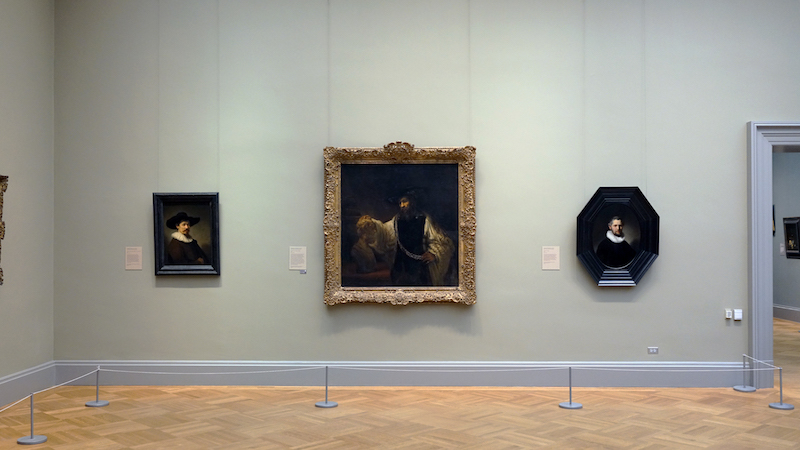
Center image: Rembrandt, Aristotle with a Bust of Homer, 1653, oil on canvas, 143.5 x 136.5 cm (The Metropolitan Museum of Art)
What makes this painting so captivating?
In 1961, the Metropolitan Museum paid a staggering 2.3 million dollars to obtain a late work by Rembrandt van Rijn, the painting now called Aristotle with a Bust of Homer. At the time, it was the most money ever paid for an artwork. The painting had taken a circuitous route: from Rembrandt’s studio in Amsterdam to Sicily to London before crossing the Atlantic and finding its home in several private collections prior to auction. Its early travels are well documented, thanks to the survival of shipping manifests and correspondence. The painting now captivates visitors to The Met, as it has captivated generations of art historians who have argued over almost every aspect of the painting. What is it that makes this painting so compelling?
Identifying the subject
The most commonly accepted identification of the subject was first convincingly argued in 1969 by Julius Held and refined in the 2007 Metropolitan Museum catalog of Dutch paintings by Walter Liedtke. Based on a suggestion made by the Dutch art historian Abraham Bredius in the 1930s, Held argued persuasively for the identification of the subject as Aristotle contemplating a bust of the blind ancient Greek poet Homer (who lived some 400 years prior to Aristotle and who is credited as the author of the of the epic poems the Iliad and the Odyssey).
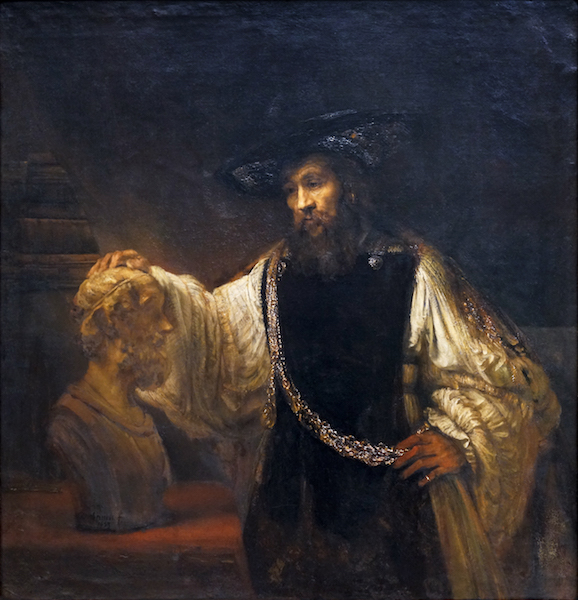
Rembrandt, Aristotle with a Bust of Homer, 1653, oil on canvas, 143.5 x 136.5 cm (The Metropolitan Museum of Art)
The identification as Aristotle is based on the facial features, long hair and beard, jewelry and elaborate dress. They are all comparable with other images of Aristotle produced in both paint and print in the sixteenth and seventeenth centuries in both northern and southern Europe. Aristotle was held in high regard not only as a poet and philosopher but also as an important commenter on Homer and the teacher of Alexander the Great. Alexander is said to have counted a volume of Homer’s works as one of his prized possessions.
At the time of The Met’s purchase, the subject of the painting was tentatively identified as Aristotle, but was not yet firmly established. This reflects the confusion also recorded in seventeenth-century sources. The painting was originally purchased (and possibly commissioned) by the Sicilian prince Don Antonio Ruffo for the hefty sum of 500 florins. Whether it was a commission or a purchase is unclear, as is exactly what Rembrandt was asked to provide. If it was a commission, the choice of subject must have been left to the painter since when it joined Don Ruffo’s collection it was described as Aristotle or Albertus Magnus (a thirteenth-century German philosopher). This suggests that even the first owner was uncertain of the subject and that decisions about content must have been made exclusively by Rembrandt.
The painting continued to be documented in numerous family inventories until the late eighteenth century. Over the years, it has been (mis)identified as “a philosopher,” Albertus Magnus, Tasso, Ariosto, Virgil and even the seventeenth-century Dutch poet Pieter Cornelisz Hooft.
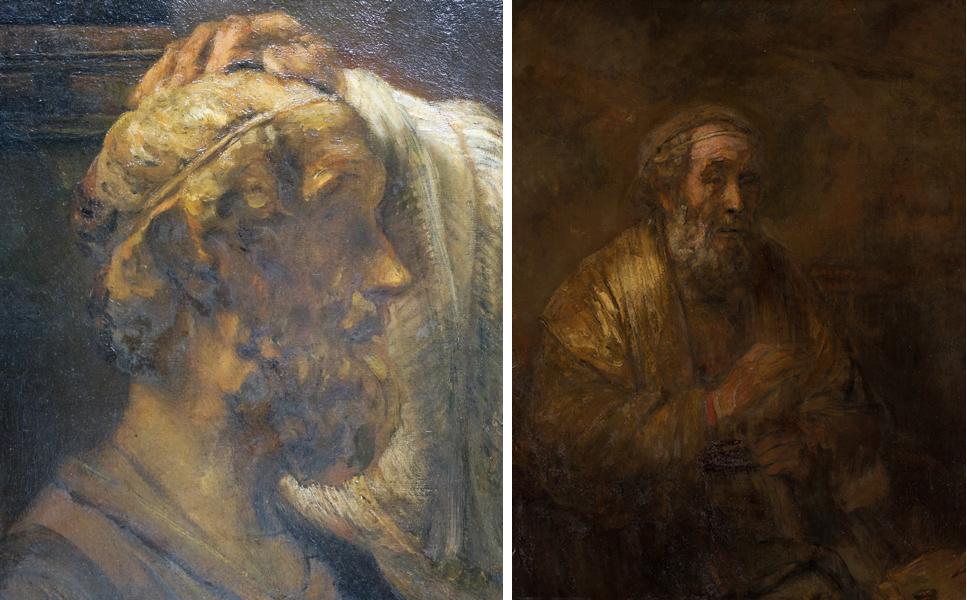
Left: Rembrandt, bust of Homer (detail) Aristotle with a Bust of Homer, 1653, oil on canvas, 143.5 x 136.5 cm (The Metropolitan Museum of Art); right: Rembrandt, Homer, 1663, oil n canvas, 107 x 82 cm (Mauritshuis)
The identity of the sculpted bust in the composition was similarly unclear. It was sometimes vaguely identified as representing antiquity, and as an attribute of the central figure. That it was intended to represent Homer can be supported in several ways.
Almost ten years after his purchase of this painting, Ruffo would go on to commission two more paintings from Rembrandt: a representation of Homer (remnants now in the Mauritshuis) and one of Alexander (now lost). The Mauritshuis Homer fragment (above) shows the blind poet isolated, though in its original format it would have included the students to whom he was speaking. The living poet in this painting is virtually identical to the bust in Aristotle. The shape of the face, the framing of the sightless eyes, and the thin band across his forehead correspond with numerous prototypes and support the firm identification of the bust as Homer. Held has even related it to a specific Hellenistic bust type represented by an example in the Boston Museum of Fine Arts. Rembrandt himself owned a bust of Homer, as it appears in his 1656 bankruptcy inventory.
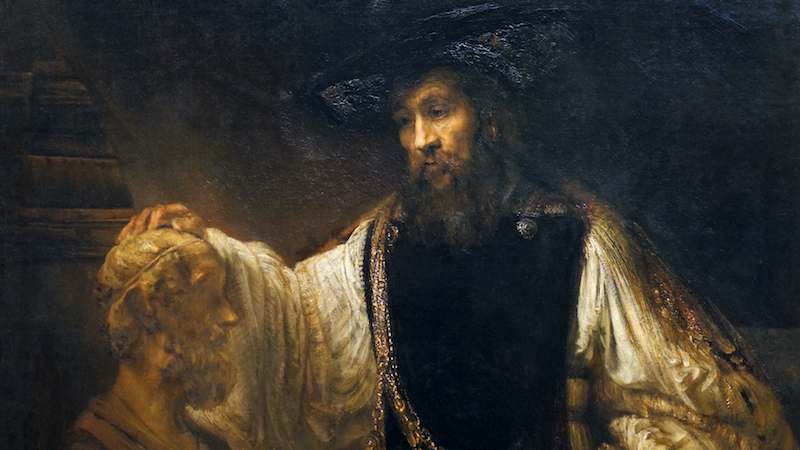
Detail, Rembrandt, Aristotle with a Bust of Homer, 1653, oil on canvas, 143.5 x 136.5 cm (The Metropolitan Museum of Art)
Aristotle
In the painting’s current state, Aristotle is depicted in three-quarter length. His right hand extends to rest on the sculpted bust placed on a table in front of a mountain of books partially hidden by a curtain, but he is not looking at the bust. His eyes are fixed on an invisible point outside the frame of the painting, his dark eyes and absent gaze contributing to a feeling of melancholy and detached reflection.
Held associated this melancholy with a passage from Plutarch which recounts that Aristotle had fallen out of favor with Alexander; Liedtke sees the melancholy as an appropriate attribute of a man of learning in the seventeenth century.
Aristotle’s clothes seem to belong to no particular period, and Rembrandt has eschewed a more traditional, toga-clad approach such as that found in Raphael’s School of Athens. Aristotle instead seems to wear an odd combination of a wide-brimmed hat, a white tunic, and a dark apron-like garment, adorned not only with a gold chain but earrings and a pinky ring. The bust itself is painted in such a warm tone that it seems almost more like flesh than stone, putting the venerable poet almost within reach. The two thinkers, living and sculpted, are linked not only by Aristotle’s gesture, but by the repeated arcs created by their clothing and accoutrements.
The brushwork
Like much of Rembrandt’s work from the last third of his life, Aristotle with a Bust of Homer uses the rich darkness of the background to set off the central figure, who is gently picked out from the darkness almost as if under a spotlight. Quick, vigorous brushwork creates the voluminous folds of Aristotle’s left sleeve; bright spots of white and light yellow crest to form the shimmering surfaces of the chain draped across his torso.
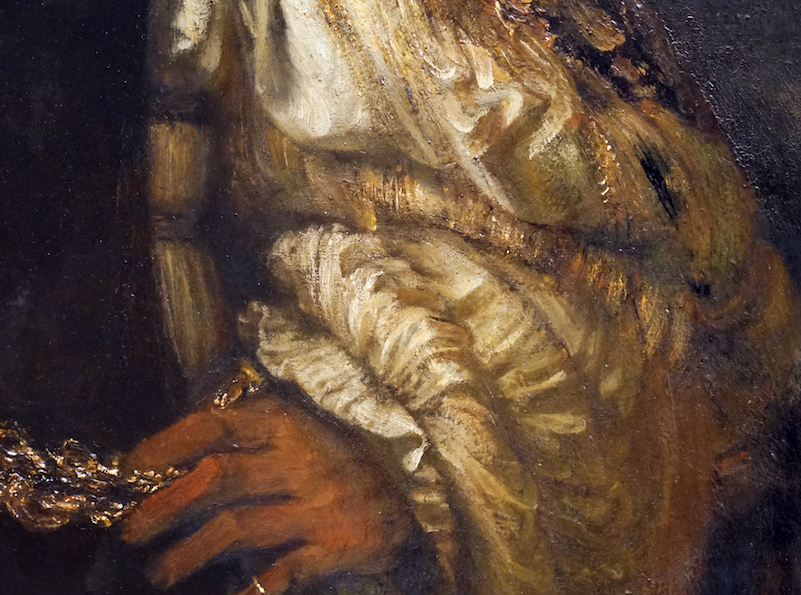
Detail, Rembrandt, Aristotle with a Bust of Homer, 1653, oil on canvas, 143.5 x 136.5 cm (The Metropolitan Museum of Art)
Though the crux of the painting is the interaction between bust and man, the highlights and surface texture carry our attention across Aristotle’s body to his left hand which, accented by a ring, rests on the chain at his hip. The background, by contrast, dissolves into obscure and ambiguous darkness, possibly enhanced over time.

Medallion (detail), Rembrandt, Aristotle with a Bust of Homer, 1653, oil on canvas, 143.5 x 136.5 cm (The Metropolitan Museum of Art)
Interpretations
Held proposed that here Aristotle ponders the temporality of worldly success as represented by the golden chain versus the more profound and lasting benefit of wisdom gained from art and literature embodied by Homer’s bust. In this sense, the formal repetition of the arc created by Aristotle’s chain and Homer’s sculpted clothing establishes the two figures as counterpoints.
Aristotle’s chain bears a medallion featuring a portrait of a man, possibly Alexander the Great. The gifting of gold chains was an ancient practice to recognize excellence and service, and had been revived in the early modern period. It is thus both an historical attribute of the figure and an easily recognizable token of honor for the contemporary viewer. The significance of the chain—both for the subject and in compositional terms—is further made evident through the care with which it was painted.
In the Poetics, Aristotle addresses, among other topics, how poetry, theater, and the arts are processes of mimesis, or imitation of the world. Through imitating the world in a new format, the poet or painter presents a new vision to the viewer and a new way of knowing the world. In selecting Aristotle as a subject, Rembrandt commemorated the role of vision—of painting itself—as a noble art.
Perhaps the appeal of the painting derives partly from the way the viewer is invited to participate and asked to contemplate a subject who, as Walter Liedtke wrote, is shown “not as a sage from whom wisdom emanates, but as a man who contemplates ethical problems and puzzles them out for himself.”
By enabling the viewer to take on the Aristotelian role of the one learning by looking, Rembrandt allows the viewer to engage, like Aristotole, in profound thought. In that regard, it was a perfect piece for an educated, thoughtful collector in the Early Modern period and remains an invitation to look and to learn for future generations of visitors to The Met.

